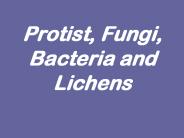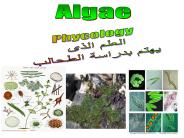Spirogyra PowerPoint PPT Presentations
All Time
Recommended
A. Spirogyra. B. Diatoms. C. Volvox. D. Scenedesmus. E. Closterium. Questions: 45-50. 46 ... Spirogyra. B. Diatoms. C. Volvox. D. Scenedesmus. E. Closterium ...
| PowerPoint PPT presentation | free to view
Ameoba. Ameoba. Protococcus. Volvox. Volvox. Euglena. Euglena. Euglena. Scenedesmus. Spirogyra. Spirogyra. Spirogyra. Ulothrix ...
| PowerPoint PPT presentation | free to view
Chapter 20 - Protists Characteristics: Eukaryotic Unicellular - may be colonial or filamentous (Spirogyra and Volvox) Animal-like, Plant-like, or Fungus-like ...
| PowerPoint PPT presentation | free to view
... Monostroma, Oedogonium, Pediastrum, Scenedesmus, Spirogyra, Ulva, Volvox ... A Volvox. Chlorophyta. U Volvox. Chlorophyta. A Spirogyra. Chlorophyta. U ...
| PowerPoint PPT presentation | free to view
Cheek Cells. Paramecium. Scenedesmus. Spirogyra. Nucleus. Lunch. Blepharisma. Hydra. Amoeba ...
| PowerPoint PPT presentation | free to view
2) the naming and classification of organisms. 3)only organisms in the ... 2)paramecium, ameba, and spirogyra. 3)bacteria, ameba, and spirogyra. Try Again! ...
| PowerPoint PPT presentation | free to view
Colonial - Volvox. Chlorophyta. Spirogyra - a common. freshwater green alga. Spirogyra conjugating. Chlamydomonas Life Cycle. Volvox. Ulva Life Cycle ...
| PowerPoint PPT presentation | free to view
True Bacteria. Filamentous Bacteria. Blue-green algae (Spirulina) Chlamydomonas. Volvox. Volvox with visible flagella. Volvox Colonies. Spirogyra. Spirogyra nucleus ...
| PowerPoint PPT presentation | free to download
... Chlorophyta Green Algae Spirogyra being eaten by a heterotroph Amoeba proteus-unicellular protozoan- Rhizopoda Rhizopoda amoebas-using pseudopodia Rhizopoda ...
| PowerPoint PPT presentation | free to view
Codium: dead man's fingers. And freshwater species. e.g., Spirogyra ... the uniform dispersal of chloroplasts and the recessed, sucking mouth. C, Two ...
| PowerPoint PPT presentation | free to view
Stigeoclonium kon asta granata Spirogyra kon asta negranata Scenedesmus nepokretna cenobija Macrocystis parenhimati na Alge prof. Sonja Kova evi
| PowerPoint PPT presentation | free to download
Introduction to Lab Ex. Photosynthetic Microbes Introduction to Lab 3: Ex. Photosynthetic Microbes Microbes that are capable of photosynthesis Found in 2 groups ...
| PowerPoint PPT presentation | free to download
II. Kingdom Protista All are eukaryotic. ... Photosynthetic; their nutrition is plant-like. Almost all of them have chlorophyll a, most have chlorophyll c, ...
| PowerPoint PPT presentation | free to download
BIO 225 Microbiology Ken Malachowsky Florence-Darlington Technical College * * * * * * * * * * * * * * * * * * * MICROSCOPE Magnifies Illuminates Contrasts Resolves ...
| PowerPoint PPT presentation | free to download
Chlorophyta: alghe verdi Chl a e b, carotenoidi Accumulano amido all interno di cloroplasti Parete rigida costituita da cellulosa, emicellulosa e pectine
| PowerPoint PPT presentation | free to download
this ppt will be very useful for student of class8
| PowerPoint PPT presentation | free to download
Chapter 11 Protists Protist Charateristics Protists unicellular or multicellular eukaryotes that may be autotrophic or heterotrophic Autotrophs are organism ...
| PowerPoint PPT presentation | free to view
Euglena. LAB 6 REVIEW. Which of the following organisms is exclusively heterotrophic? ... Euglena. LAB 6 REVIEW. 2 Identify the organism shown. LAB 2 REVIEW. 2 ...
| PowerPoint PPT presentation | free to download
... Bactrian Camel and Llama B: Bactrian camel and Dromedary C: Bactrian camel and sea star Scientific Name (Binomial Nomenclature = 2 word naming system) ...
| PowerPoint PPT presentation | free to download
... Slide 33 Ascomycete Deuteromycetes Lichens Crustose Lichen Foliose Lichen Fruiticose Lichen Algae Pyrrophyta Chrysophyta Phaeophyta Rhodophyta Virus ...
| PowerPoint PPT presentation | free to download
Protists What is a protist? Protist Diversity Diseases Caused by protists Protists Have Complex Cells Eukaryotic-with a nuclear membrane Membrane bound organelles ...
| PowerPoint PPT presentation | free to view
Protist, Fungi, Bacteria and Lichens bacillus Coccus Spirillium Strepto Staphlo Bacteria s Tail (Flagella) Bacteria s Tail (Flagella) Amoeba Kingdom ...
| PowerPoint PPT presentation | free to download
Title: Practical Review Practice( SemI) Author: psidelsky Last modified by: psidelsky Created Date: 1/13/2005 2:47:11 PM Document presentation format
| PowerPoint PPT presentation | free to view
Mougeotia Rod m dlouh tenk bu ky s jedin m chloroplastem ve tvaru desky se dv ma nebo v ce pyrenoidy. Mesotaenium Rod m kr tce cylindrick bu ky s ...
| PowerPoint PPT presentation | free to download
The Refinement of a Good Protocol for Rubisco Isolation ... 80o vs 20oC. Boiling Proteins. Final Coomassie. Spinach 80 v -20. Boiled Proteins. Final Western ...
| PowerPoint PPT presentation | free to view
Homework Summarizing concepts 3 and 4 pg. 521 Character Ed Objectives Distinguish plant-like protists. Describe how protists affect humans. Protists!
| PowerPoint PPT presentation | free to view
Ulva, sea lettuce, a green alga. Green algae - Chlamydomonas (Chlorophyta) ... Green algae - Volvox. Green algae - Micrasterias thomasiana ...
| PowerPoint PPT presentation | free to view
Living organisms are classified into 3 Domains 1. Bacteria 2. Archaea 3. Eukarya 4 Kingdoms in this Domain
| PowerPoint PPT presentation | free to view
Use of New Tools for Managing Risks Microbial Source Tracking
| PowerPoint PPT presentation | free to download
The Classification of Living Organisms The Five Kingdoms The Five Kingdom Classification of Living Organisms It is generally agreed that all organisms belong to one ...
| PowerPoint PPT presentation | free to view
Cyanobacteria (Blue-green algae) photosynthesis - i.e. Aphanizomenon flos-aquae, Anabaena ... Asexual reproduction of females ...
| PowerPoint PPT presentation | free to view
Thylakoids stack on top of one another to form. Characteristic columns called? C: D: ... CAM plants open stomata during the night and close them during the day ...
| PowerPoint PPT presentation | free to view
Title: Kingdom Protista Author: teacher Keywords: Kingdom Protista Description: Kingdom Protista Last modified by: Dad Created Date: 9/27/2004 11:20:49 AM
| PowerPoint PPT presentation | free to view
REGNO DEI PROTISTI Prof.ssa Elena Truffo Anno scolastico 2004/05 Caratteristiche Eucarioti Per la maggior parte sono unicellulari, alcune alghe (in particolare rosse ...
| PowerPoint PPT presentation | free to download
Seaweeds and kelps, may be as long as 60m. Water Molds (oomycota) white rusts and downy mildews Diatoms Golden Algae - Chrysophyta Brown Algae ...
| PowerPoint PPT presentation | free to download
Classification and Biodiversity Fungi Plants Bryophyta: mosses Tracheophyta: plants with vessels About _1.5 million___ kinds of living organisms are known today and ...
| PowerPoint PPT presentation | free to view
... Moist Environments Phylum Acrasiomycota Cellular Slime Mold No cell wall Unicellular but colonize Phylum Myxomycota Acellular Slime Mold Fuse together to ...
| PowerPoint PPT presentation | free to download
20-1 The Kingdom Protista What Is a Protist?-Any organism that is not a plant, animal, fungus, or a prokaryote-Catch All Kingdom mostly unicellular, eukaryotes
| PowerPoint PPT presentation | free to view
Supergroup: Chromalveolata; Clade: Ciliates. Blepharisma ... Volvox. Supergroup: Archaeplastida; Clade: Chlorophytes. Scenedesmus ...
| PowerPoint PPT presentation | free to view
This is a protist that can cause serious disease and is in a genus often transmitted by sandflies. This protist feeds by absorbing food across its membrane.
| PowerPoint PPT presentation | free to view
Kingdom Protista
| PowerPoint PPT presentation | free to download
Title: Zygnemataceae Author: Ross Koning Last modified by: Biology Department Created Date: 10/20/2004 2:24:15 AM Document presentation format: On-screen Show
| PowerPoint PPT presentation | free to download
Algae - 3 General characters *
| PowerPoint PPT presentation | free to view
Title: Biology 5/15/07 Objectives: To learn about taxonomy. Class Topics Hand in Shark Key W.S. before the bell rings Chapter 16 exam review
| PowerPoint PPT presentation | free to download
Title: Protozoans: Non-motile Author: Bill Last modified by: Default Created Date: 5/3/2005 1:46:28 AM Document presentation format: On-screen Show
| PowerPoint PPT presentation | free to view
microscopic to seaweeds hundreds of feet in length. Do not have true ... Stemlike structures are called the stipe. Store food as a carbohydrate called laminarin ...
| PowerPoint PPT presentation | free to view
Green algae can be found as single cells, ... Volvox are green algae that live in colonies. The volvox in these colonies communicate and share resources. ...
| PowerPoint PPT presentation | free to view
Title: No Slide Title Author: Cary Harr Last modified by: Thomas Curran Created Date: 11/3/1999 8:59:30 PM Document presentation format: On-screen Show
| PowerPoint PPT presentation | free to download
few colonies showing division of labor. either photosynthetic ... Pellicle -- submembrane protein. fresh water habitats. have a photosensetive eyespot -- Stigma ...
| PowerPoint PPT presentation | free to view
Title: Slide 1 Author: ACER Last modified by: Saika Aulia Created Date: 10/2/2006 12:50:47 PM Document presentation format: On-screen Show Company
| PowerPoint PPT presentation | free to download
KINGDOM PROTISTA Plant-like- Algae Animal-like- Protozoa Fungi-like- Slime Molds PHYLUM CHOROPHYTA (GREEN ALGAE) GREEN ALGAE CHLAMYDOMONAS Movement- two flagella ...
| PowerPoint PPT presentation | free to download
EARLY EARTH and the ORIGIN OF LIFE ...
| PowerPoint PPT presentation | free to view
























































